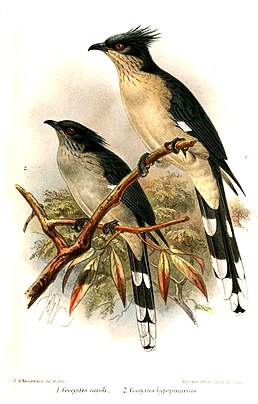Чубата зозуля
| Чубата зозуля | ||||||||||||||||
|---|---|---|---|---|---|---|---|---|---|---|---|---|---|---|---|---|
 Строкаті зозулі (Clamator jacobinus)
| ||||||||||||||||
| Біологічна класифікація | ||||||||||||||||
| ||||||||||||||||
Види
| ||||||||||||||||
| Синоніми | ||||||||||||||||
| Edolius Lesson, 1830[2] | ||||||||||||||||
Посилання
| ||||||||||||||||
|
Чубата зозуля[6] (Clamator) — рід зозулеподібних птахів родини зозулевих (Cuculidae)[7]. Представники цього роду мешкають в Африці і Євразії[8][9].
Чубаті зозулі — відносно великі зозулі, середня довжина яких становить 34-45 см, а вага 66-141 г. Їх притаманні довгі вузькі хвости і широкі крила і не притаманний статевий диморфізм. На голові у них є помітний чуб. Верхня частина тіла у чубатих зозуль темна, переважно сіра, коричнева або чорна, а нижня частина тіла світла. Африканські види чубатих зозуль мають дві морфи — темну і світлу.
Чубаті зозулі практикують гніздовий паразитизм. Вони відкладають одне яйця в гнізда птахів середнього розміру, зокрема сорокам, шпакам, сорокопудам, чагарницям, бюльбюлям і тимеліям, в залежності від регіону.
Виділяють чотири види:[10]
- Зозуля каштановокрила (Clamator coromandus)
- Зозуля чубата (Clamator glandarius)
- Зозуля африканська (Clamator levaillantii)
- Зозуля строката (Clamator jacobinus)
Наукова назва роду Clamator походить від слова лат. clamator — крикун (від clamare — кричати).[11].
- ↑ Kaup, Johann Jakob (1829). Skizzirte Entwickelungs-Geschichte und Naturliches System der Europaischen Thierwelt (German) . Darmstadt: In commission bei Carl Wilhelm Leske. с. 53.
- ↑ R.P. Lesson: Traité d’ornithologie, ou, Tableau méthodique des ordres, sous-ordres, familles, tribus, genres, sous-genres et races d’oiseaux: ouvrage entièrement neuf, formant le catalogue le plus complet des espèces réunies dans les collections publiques de la France. Bruxelles: Chez F.G. Levrault, 1831, s. 147.
- ↑ C.L.W. Gloger. Bortrag über die allgemeine geographische Berbeitung der Landvögel, jedoch blos mit Berücksichtigung der Gattungen und der Unterabtheilungen (Sectionen, Familien) in den Gattungen. „Jahres-Bericht der Schlesischen Gesellschaft für Vaterländische Cultur”. 10, s. 53, 1832.
- ↑ P.W. von Wuerttemberg. Verzeichniss Central-Africanischer und Nord-Africanischer Vögel. „Naumannia”. 7, s. 434, 1857.
- ↑ A. Roberts. A review of the nomenclature of South African birds. „Annals of the Transvaal Museum”. 8, s. 219, 1921–1922.
- ↑ Фесенко Г. В. Вітчизняна номенклатура птахів світу. — Кривий Ріг : ДІОНАТ, 2018. — 580 с. — ISBN 978-617-7553-34-1.
- ↑ R.B. Payne: Family Cuculidae (Cuckoos). W: J. del Hoyo, A. Elliott & J. Sargatal: Handbook of the Birds of the World. Cz. 4: Sandgrouse to Cuckoos. Barcelona: Lynx Edicions, 1997, ss. 547–548. ISBN 84-87334-22-9.
- ↑ Payne, R.B. (2005). The Cuckoos. Oxford University Press. ISBN 0-19-850213-3.
- ↑ Friedmann, H (1964). Evolutionary trends in the genus Clamator. Smithsonian Miscellaneous Collections. 146 (4): 1—106.
- ↑ Gill, Frank; Donsker, David; Rasmussen, Pamela, ред. (2022). Turacos, bustards, cuckoos, mesites, sandgrouse. IOC World Bird List Version 12.1. International Ornithologists' Union. Процитовано 26 травня 2022.
- ↑ Jobling, James A. (2010). The Helm Dictionary of Scientific Bird Names. London: Christopher Helm. с. 110. ISBN 978-1-4081-2501-4.
- N. B. Davies: Cuckoos, Cowbirds and Other Cheats. T & AD Poyser, London 2000, ISBN 0-85661-135-2.
- Johannes Erhitzøe, Clive F. Mann, Frederik P. Brammer, Richard A. Fuller: Cuckoos of the World. Christopher Helm, London 2012, ISBN 978-0-7136-6034-0.
| Це незавершена стаття з орнітології. Ви можете допомогти проєкту, виправивши або дописавши її. |
